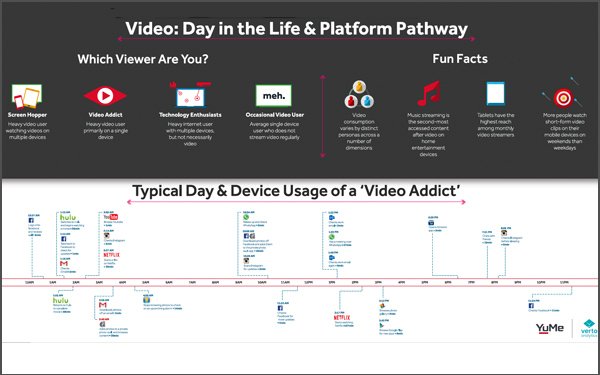Did you ever wonder what a “day in the digital life” of a video consumer is? We know our own individual digital paths, but what about consumers in aggregate?
New research from audience technology firm YuMe and audience measurement provider Verto Analytics defines video consumption by four
distinct personas:
Screen-Hopper: A heavy video user who watches videos on multiple devices, spending the most weekly hours online.
Video Addict: A single-device, heavy
video user who spends the most time watching video, but also has the highest frequency of video sessions.
Technology Enthusiast: This user consumes content on multiple devices, but not
necessarily video. [S]he has the second highest weekly hours online, but is often more interested in other online activities, like gaming.
Occasional Video User: A single-device user
who doesn’t stream video regularly. Use of long-form video service is largely concentrated in the mornings and early evenings, and often limited to a single session per day.
advertisement
advertisement
Do any of
these video personas align with your video consumption? If not, what is your video persona?
The goal of the research, according to YuMe, was to identify the depth and breadth of media
consumers touch throughout the day. Clearly, consumers engage with apps and video across computers, smartphones, tablets, connected TV, gaming consoles, and other media streaming devices.
"The
study reveals the intersection of two key concepts: ‘audience first’ and 'liquid audiences.' Our research has revealed four distinct personas, with the key takeaway for brands being that
each of these personas has very fluid viewing habits,” Stephanie Gaines, YuMe’s vice president, corporate marketing, told RTBlog via email.
“It’s only by going
beyond the traditional segmentation models—going deeply into behavioral and most important, contextual understandings of each persona—that you can fully appreciate how dynamic each persona
is," she added. "Engagement via video can become extraordinarily powerful, when you consider the fluid dynamics of liquid audiences.”
The study also revealed the smartphone’s
dominance as the primary connected household device and also highlighted strong growth in streaming media player use.
The idea of a “liquid audience” as defined by YuMe is
charactized by dynamic movement across devices and more variable video viewing behaviors, according to Paul Neto, senior research director, YuMe. “Digital video—both ad-supported and
subscription-based—provides prime opportunities for advertisers, brands and media to impact the 24-hour journey of digital engagement,” Neto stated.
The takeaway here is that in
order for brands to influence and engage with the consumer segment of their choice, they need to employ a multi-platform video strategy with cohesive messaging that optimizes for reach, frequency, and
relevancy.
Other findings include:
Consumers’ daily digital journey includes numerous device touch points: Sixty-four percent of game console owners own or use regularly a
tablet. Eighty-one percent of users who own or regularly use a streaming media device own a PC.
This is not at all surprising; people have been talking about “numerous touch
points” for years. What is newer is the number and variety of device types, and the fact that consumers switch back and forth among devices and platforms more frequently than ever.
A
small number of users generate the majority of video sessions: Ten percent of users generate 60% of long-form and 43% of short-form video sessions.
Smartphones are the most prevalent
household device: Smartphones surpassed PCs as the most prevalent household device, while streaming media players recorded the biggest growth among all video device types in 2015. Tablets have the
highest reach among monthly video streamers.
Connected home devices are additive, not replacements, for existing devices: Connected home entertainment devices such as smart TVs,
streaming media players, and game consoles are complementing primary online devices like PCs, smartphones, and tablets, rather than competing against them.
The concept of complementing vs.
competing devices offers new possibilities for advertisers to develop new forms of creative.
The research found that while smartphone and PC usage peaks throughout the day, consumers shift to
entertainment in the evening on home entertainment devices. Music streaming is the second-most accessed content after video on home entertainment devices.
Data for the research was collected
using the Verto Smart Panel, a patented measurement tool that presents all screens and media types in a statistically driven, single-source measurement panel. Participants included approximately 8,000
U.S. adults over the age of 18.
